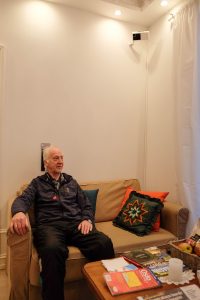Welhavens street 5, a technological apartment building



The population of Oslo will increase in age in the coming years. As a result, the demand for public health services will increase and the municipality wants to give service users who want to live at home access to adequate health services. To prepare for this, the municipality’s healthcare services have started using technology. As the municipality gained more experience with the use of technology, they saw the potential to safeguard residents with cognitive challenges and dementia in a way that requires less manpower and at the same time giving the residents more freedom. This sparked the idea of Welhavens street 5. Welhavens street 5 is a municipal apartment building with 10 apartments. It has been renovated and tailor-made to fit the needs of older people experiencing cognitive decline. The residents receive home nursing from regular home care if needed.
Technology such as sensors, anonymous cameras, GPS watches, automatic medicine dispensers and automatic voice instructions make sure that residents can have a more open environment than they would in a traditional home for older people experiencing cognitive decline. The residents are encouraged to keep their habits and continue doing activities that are meaningful to them. Our goal is to give them safety and stability with as little restriction as possible. Each resident has individually adapted service. It is now 2 years since Welhavens street 5 opened. Some residents have ended their lives there, and some have eventually been forced to move to a nursing home, yet all have had the opportunity to live independently for longer.
Main target group: Older people with chronic health conditions or disability
Other target group(s): Older people with cognitive challenges and dementia
Sector(s): Health, Housing, Information and communication, Long-term care
Desired outcome for older people:
Be mobile
Name: Lystad, Thomas
Email address: thomas.lystad@bsh.oslo.kommune.no
Preferred language(s): English/Norwegian